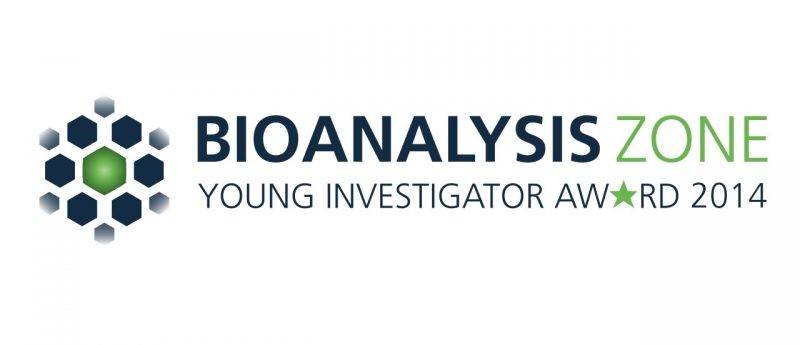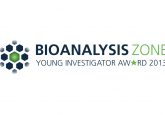Interview with XiuJun (James) Li (University of Texas at El Paso) on winning the 2014 Bioanalysis Young Investigator Award

 I understand you have recently developed a microfluidic device for the detection of infectious diseases. Could you briefly summarize how this device works?
I understand you have recently developed a microfluidic device for the detection of infectious diseases. Could you briefly summarize how this device works?
We have recently developed a versatile, cost effective paper/polymer hybrid biochip integrated with loop mediated isothermal test (LAMP) for instrument-free diagnosis of infectious diseases. This is an ongoing project supported by the USA National Institutes of Health (NIH). Various materials including silicon, glass, polydimethylsiloxane (PDMS) and paper have been used for microfluidic device fabrication. Each substrate material has its own advantages and limitations, however, paper/polymer hybrid microfluidic devices that draw benefits from both substrates are rarely reported. Previously, we developed a paper/PDMS hybrid microfluidic device integrated with nanosensors for pathogen detection [1], in which paper facilitated the integration of nanosensors on the chip and avoided cumbersome surface modification. In this work, we integrated DNA amplification with a paper/PDMS hybrid microfluidic point-of-care (POC) device. Interestingly, we found the hybrid POC provided a much more stable performance than a paper-free system over a period of 2 months. To improve the field detection capacity, we have also developed a centrifuge-free method to lyse patient samples. This hybrid system offers versatile functions by providing not only on-site qualitative diagnostic analysis (i.e. a yes or no answer), but also confirmatory testing and quantitative analysis in laboratory settings.
The disease diagnosis based on this POC device is very simple and user-friendly. An operator just needs to introduce the patient sample mixed with bioassay regents into the ready-to-use biochip, and heat at 63 °C for 45 min. By illuminating the chip with a portable UV light pen (approximately $5), the operator can determine the diagnostic test results immediately, without the use of a centrifuge or other specialized laboratory equipment, using the naked eye. Although no specialized instrument was used, our method provided high detection sensitivity. A limit of detection down to 3 DNA copies per zone was achieved, which was even lower than that of the currently widely used real-time PCR. For detailed information about this work, you can read our recent publication [2]. I would like to thank my graduate student Maowei Dou who contributed greatly to this project.
What are the benefits of simple, cost effective POC devices?
The benefits are numerous and significant, especially for human, animal and plant disease diagnosis in low-resource settings. Although there are many high-end instruments that have been used for bioanalysis, they are often not applicable in low-resource settings such as field diagnosis, infectious disease monitoring at the patient’s bedside and in public venues, due to the expensive and bulky instrumentation. One important characteristic of infectious diseases is that they often occur in high-poverty regions, such as developing nations. Many diseases are not diagnosed in due course as people in these countries do not have access to diagnostic equipment for the previously stated reasons. This results in the infectious disease spreading to other people and regions (e.g. the recent Ebola outbreak in West Africa). Under these scenarios, if a simple, cost effective POC device is available, it will significantly benefit millions of people throughout the world. In the near future I hope our POC device will be as simple as a pregnancy test strip.
When do you believe your POC device will be commercially available?
We are spinning up a biotech company to commercialize the POC devices and I am currently seeking partners in industry to help with this commercialization. We have submitted two patent applications. In addition, some biotech companies have already showed interest in this POC device. Therefore, I hope our devices will be commercially available within 3–5 years. Our POC devices should have broad applications for various infectious diseases, not just for one disease. Should this POC device be of your or your company’s interest, please contact me via [email protected].
Another focus of your research is single cell analysis. Please could you provide an overview of your work in this area?
The main advantage of single-cell analysis over conventional bulk analysis is that it can reveal rich information about the differences among individuals or cellular heterogeneity (i.e. cells are different). However, the cellular heterogeneity bothered me a lot when studying the reversal effect of multidrug resistance (MDR) modulators. I found that the reversal effect of MDR modulators was quite different among different runs of my experiments. When compared to control experiments (no drug) done on different cells, the positive drug effects were often obscured. Sometimes it was even hard to tell the positive drug effect of well-known MDR modulators. I was confused and it took me quite some time to discover that the problem was caused by the cellular heterogeneity. To address the issue, I put forward a new concept of “Same-single-cell analysis (SASCA)”. This technique is different to conventional methods as the same cell is used for the study of the positive drug effect and the negative control, thus ruling out cellular variations that are observed when comparing the positive drug effect from one cell with the negative control from another cell. Thus, we have applied SASCA to solve MDR problems successfully [3,4].
It is not usually feasible to use conventional methods like flow cytometry (requires a large amount of samples) in the discovery of personalized medicine, as we can usually only get a small amount of sample from a patient. However, our microfluidic SASCA method only requires a tiny amount of patient samples (e.g. blood samples). Therefore, SASCA is envisioned for clinical use as a prognostic method, e.g. to check the MDR profile and drug responses so we can look for personalized drugs before patient treatment starts [5].
How does it feel to have won the 2014 YIA?
I am excited to be chosen as the winner of the 2014 Bioanalysis Young Investigator Award. It is my great pleasure to be recognized by this reputable award and by the international bioanalysis community. I believe this award will encourage me to work harder with my colleagues and contribute more to this ever growing field of bioanalysis. I also want to take this opportunity to thank my mentors (Paul Li, George Whitesides and Richard Mathies) for their invaluable training in this field.
Over the next few years what will be the focus of your work?
Over the next few years, my research will focus on two directions, one of which is to study the fundamentals and mysteries of important cellular phenomena, such as single-cell analysis, organ-on-a-chip [6]. The other direction aims to address challenging practical problems by developing innovative POC devices and nanosensing methods, such as POC devices for rapid diagnosis of infectious diseases, cancer screening and so on. For instance meningitisis one of most deadly global infectious diseases, infected people can die within 24 hours if the disease is not diagnosed and treated quickly. Many developing nations cannot afford expensive and bulky instruments. I hope the ‘little’ POC devices that I am working on could help our ‘big’ world [2].
Nominations for the 2015 Young Investigator Award are now open, click the following link for full details and a nomination form.
Positions available!
If any young bioanalysis researchers (e.g. graduate students and postdoctoral fellows) are interested in these bioanalytical fields, you are more than welcome to contact me ([email protected]) for future positions and potential collaborations. Please also feel free to view my group website (http://li.utep.edu) for more information. My group has a postdoc position currently available, and graduate student positions available for Fall 2015.
Additional Materials
Slides from XiuJuns presentation at the EBF 7th Open Symposium avaliable here.
References
1. Zuo P, Li XJ, Dominguez DC & Ye B-C. A PDMS/paper/glass hybrid microfluidic biochip integrated with aptamer-functionalized graphene oxide nano-biosensors for one-step multiplexed pathogen detection. Lab Chip 13, 3921–3928 (2013).
2. Dou M, Dominguez DC, Li XJ, Sanchez J & Scott G. A versatile PDMS/paper hybrid microfluidic platform for rapid and sensitive infectious diseases diagnosis. Anal. Chem. 86(15), 7978–7986 (2014).
3. Li XJ, Chen Y & Li PCH. A simple and fast microfluidic approach of same-single-cell analysis (SASCA) for the study of multidrug resistance modulation in cancer cells. Lab Chip 11, 1378–1384 (2011).
4. Li XJ, Ling V & Li PCH. Same-single-cell analysis for the study of drug efflux modulation of multidrug resistant cells using a microfluidic chip. Anal. Chem. 80(11), 4095–4102 (2008).
5. Mukhopadhyay R. SASCA tackles single drug-resistant cancer cells. Anal. Chem. 80, 3951 (2013).
6. Li XJ, Valadez AV, Zuo P & Nie Z. Microfluidic 3D cell culture: potential application for tissue-based bioassays. Bioanalysis 4(12), 1509–1525 (2012).
For additional publications by my group, please view the following page: http://science.utep.edu/li/index.php/publications.
Click here to view XiuJun’s profile for the Young Investigator Award.




